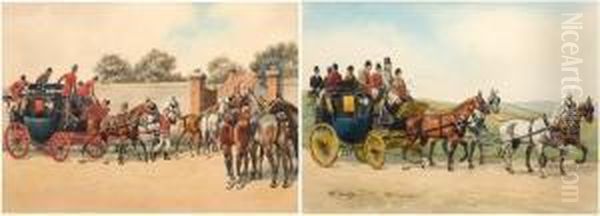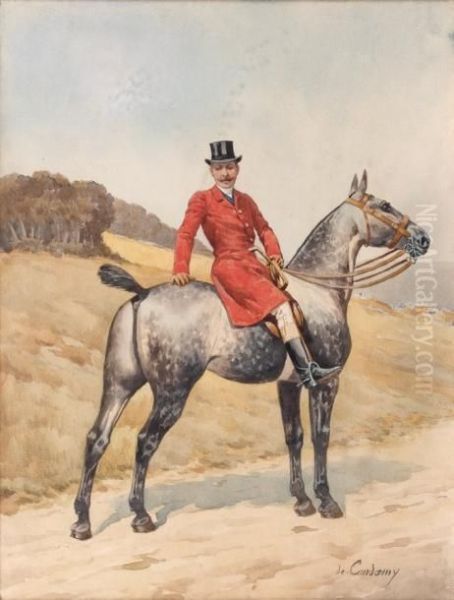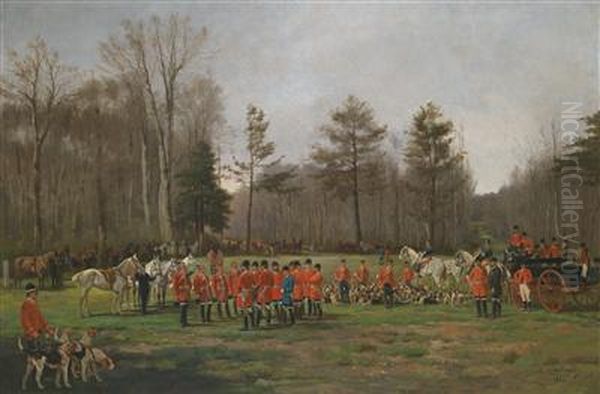Charles Fernand de Condamy stands as a notable figure in late 19th and early 20th-century French art, particularly celebrated for his dedication to capturing the vibrant world of equestrianism and the hunt. A skilled painter working primarily in watercolor and oils, Condamy carved a distinct niche for himself within the rich tradition of French animal painting, leaving behind a body of work admired for its detail, energy, and faithful representation of sporting life during his era. Though perhaps less known than the revolutionary Impressionists who were his contemporaries, Condamy's art offers a valuable window into the specific tastes and pursuits of French society at the time.
Biographical Sketch
Born in France in 1847, Charles Fernand de Condamy's life spanned a period of significant social and artistic change, extending into the early years of the 20th century until his death in 1913. Details about his personal life and formal artistic training remain relatively scarce compared to some of his more famous contemporaries. However, his active period firmly places him within the context of the French Third Republic, an era that saw both the consolidation of academic artistic traditions and the explosive emergence of avant-garde movements.
Despite the lack of extensive biographical documentation, Condamy's artistic output clearly indicates a deep familiarity and passion for his chosen subjects. His consistent focus suggests either personal involvement in equestrian activities or dedicated observation. He operated within a well-established market for sporting and animal art, catering to patrons who appreciated depictions of leisure, country life, and the noble bearing of horses and hounds. His French nationality is consistently confirmed across art historical records and auction house documentation.
The Heart of the Hunt: Subject Matter

Condamy's oeuvre is overwhelmingly dedicated to the horse and the activities surrounding it. He was particularly drawn to the dynamic scenes of the hunt, a popular pastime among the French aristocracy and upper bourgeoisie. His works frequently depict moments like the "Départ de chasse" (Departure for the Hunt), capturing the anticipation and energy of riders and hounds preparing for the chase. He painted carriages drawn by spirited horses, such as in "L’attelage à galop" (Carriage at a Gallop), showcasing his ability to convey speed and movement.
Beyond the action of the hunt, Condamy also focused on quieter moments. Works like "Cheval et chiens au repos" (Horse and Hounds at Rest), held in the museum collection in Senlis, demonstrate his skill in portraying animals in relaxed, naturalistic poses. He painted individual horses ("Cavalier" - Horseman) and groups of hounds ("Les chiens Beagles" - Beagle Hounds), paying close attention to the specific characteristics of different breeds and the details of tack and attire. Scenes like "Relais de chevaux à l'auberge" (Horse Relay at the Inn) further illustrate his interest in the everyday interactions involving horses during his time.
Style and Technique
Condamy worked confidently in both watercolor and oil paint, often enhancing his watercolors with gouache or highlights to add depth and vibrancy. His style can be broadly characterized as realistic or naturalistic, aligning with the strong tradition of representational art that persisted alongside modernist experiments. He possessed a keen eye for animal anatomy, rendering horses and dogs with accuracy and a sense of lifelike presence. His ability to capture the texture of a horse's coat, the tension in its muscles, or the alert posture of a hound contributed significantly to the appeal of his work.
While not an Impressionist concerned with capturing fleeting light effects, Condamy certainly knew how to imbue his scenes with atmosphere and energy. His compositions are typically well-structured, guiding the viewer's eye through the narrative of the scene, whether it's the organized chaos of a hunt meet or the focused power of a galloping team. His use of color was generally naturalistic, reflecting the tones of the countryside, animal coats, and traditional riding attire. The choice of medium often influenced the final effect: watercolors lent themselves to fluid, energetic sketches, while oils allowed for richer textures and more detailed finishes.
Notable Works
Several specific works help illustrate the scope and quality of Condamy's art:

_Départ de chasse_ (Departure for the Hunt): Often depicted in watercolor and gouache, these scenes capture the quintessential start of a hunt, featuring mounted riders, packs of hounds, and often carriages, set against a country landscape. A version dated to the late 19th century, measuring 32 x 49.5 cm, highlights his skill in this popular theme.
_Cavalier_ (Horseman): An oil painting from 1894 (48 x 35.5 cm), likely a portrait of a specific rider or a study of equestrian form, showcasing his ability to render both horse and human figure with detail.
_La chasse au sanglier_ (The Boar Hunt): Dated 1905, this watercolor and oil piece (32.4 x 85 cm) tackles a more specific and dramatic hunting subject, demonstrating his versatility within the sporting genre.
_Les chiens Beagles_ (The Beagle Hounds): A smaller work (15.5 x 23 cm) from the late 19th century, focusing solely on the hounds, likely appealing to enthusiasts of the breed and the hunt.
_Relais de chevaux à l'auberge_ (Horse Relay at the Inn): This watercolor depicts a common scene from the era of horse-drawn transport, showcasing everyday equestrian life beyond the formal hunt.
_L’attelage à galop_ (Carriage at a Gallop): These works capture the dynamism of horse-drawn carriages moving at speed, a testament to his skill in depicting motion.
These examples, often appearing in auction catalogues with estimates ranging from several hundred to over a thousand euros, underscore the consistent collector interest in his specialized output.
Condamy in Context: The Animalier Tradition
Charles Fernand de Condamy worked within a strong and respected tradition of animal painting, known in French as the animalier school. The 19th century saw a significant rise in the prominence of artists specializing in animal subjects. This was fueled by several factors: the scientific curiosity of the Enlightenment extending into detailed studies of the natural world, the Romantic fascination with the power and untamed spirit of animals, and the patronage of a wealthy class interested in subjects related to land ownership, sport, and pedigree.
Condamy's focus on horses and hunting places him alongside other notable French artists who excelled in similar themes. Alfred de Dreux (1810-1860) was a highly fashionable equestrian painter earlier in the century. John Lewis Brown (1829-1890), though born in Bordeaux, was also known for his elegant depictions of horses, hunting, and military scenes. Even the great Romantic painter Eugène Delacroix (1798-1863) and the master of realism Théodore Géricault (1791-1824) produced powerful images of horses, demonstrating the subject's appeal across different artistic temperaments.

Perhaps the most famous animalier of the 19th century was Rosa Bonheur (1822-1899), renowned for her large-scale, meticulously rendered paintings like The Horse Fair. While Bonheur tackled a wider range of animals, her dedication to anatomical accuracy and capturing the spirit of her subjects provides a point of comparison for Condamy's own aims. Earlier figures like Carle Vernet (1758-1836) had also laid groundwork in depicting equestrian subjects with flair. The sculptor Antoine-Louis Barye (1795-1875), while working in three dimensions, profoundly influenced the perception and status of animal art through his dramatic bronzes. Condamy, therefore, inherited and contributed to a well-established and appreciated genre.
Contemporaries and Artistic Milieu
While Condamy specialized, the period of his activity (roughly 1870s-1913) was one of the most dynamic in French art history. He worked concurrently with the Impressionists and Post-Impressionists, artists who were radically redefining the nature of painting. While there's no evidence Condamy participated in their exhibitions or shared their stylistic goals, their presence formed the backdrop to his career.
Artists like Claude Monet (1840-1926) and Camille Pissarro (1830-1903) were revolutionizing landscape painting, focusing on light and atmosphere. Edgar Degas (1834-1917), interestingly, shared Condamy's interest in horses, but focused primarily on the modern life subject of racetracks and ballet dancers, employing innovative compositions and perspectives. Pierre-Auguste Renoir (1841-1919) celebrated scenes of leisure and portraiture with a vibrant palette.
Later contemporaries included Post-Impressionists like Paul Cézanne (1839-1906), who structurally re-envisioned form; Georges Seurat (1859-1891), who developed Pointillism; and Henri de Toulouse-Lautrec (1864-1901), who captured the energy of Parisian nightlife. The existence of these avant-garde movements highlights the diversity of the Parisian art world. Condamy represented a more traditional, yet commercially viable, stream within this complex ecosystem, catering to a specific clientele whose tastes remained rooted in representational sporting art. There is no documented evidence of direct collaboration or significant rivalry between Condamy and these or other specific painters; he appears to have operated successfully within his chosen specialization.
Market Presence and Legacy
The continued appearance of Charles Fernand de Condamy's works at auction indicates an enduring appreciation among collectors, particularly those interested in sporting art, equestrian themes, and French 19th-century painting. Auction results, while varying based on size, medium, condition, and subject, consistently place his works in a respectable mid-tier market category. Prices ranging from €300-500 to €1000-1500 for characteristic pieces suggest a stable demand.
His inclusion in museum collections, such as the Musée de la Vénerie (Museum of Hunting) in Senlis, further solidifies his status as a recognized contributor to his genre. While not an innovator who changed the course of art history like the Impressionists, Condamy fulfilled an important role as a skilled and dedicated visual chronicler of a specific aspect of French life. His paintings offer more than just depictions of animals and sport; they are documents of the social customs, attire, and leisure pursuits of his time.
His legacy lies in his consistent and capable portrayal of the horse and the hunt. For enthusiasts of equestrian history, sporting art, and traditional French painting, Condamy's work remains appealing and valuable. He represents a successful specialist painter who understood his audience and mastered the techniques required to bring his chosen subjects to life with accuracy and charm.
Conclusion
Charles Fernand de Condamy was a talented French artist who dedicated his career to the depiction of horses, hounds, and the hunt. Active during a transformative period in art history, he remained focused on his specialized niche, producing realistic and engaging works primarily in watercolor and oil. His paintings, such as Départ de chasse and Cavalier, capture the energy and elegance of the equestrian world that fascinated patrons in late 19th and early 20th-century France. Situated within the animalier tradition alongside figures like Alfred de Dreux and Rosa Bonheur, and working concurrently with but stylistically distinct from Impressionists like Monet and Degas, Condamy created a body of work that continues to be appreciated by collectors and offers a valuable glimpse into the sporting life of a bygone era. His art stands as a testament to the enduring appeal of equestrian subjects and the skill required to render them effectively.